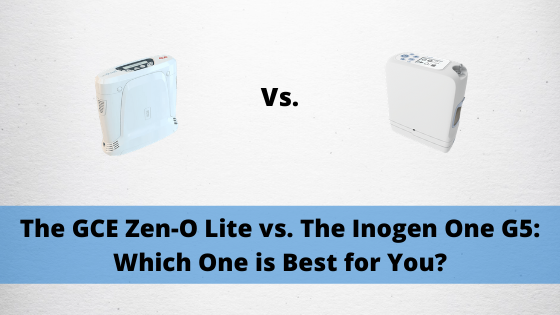
If you’ve spent some time perusing the internet for oxygen supplies, oxygen concentrators, or oxygen companies, you’re probably well aware of how difficult it can be to find exactly what you’re looking for. While you want simple and straightforward solutions to your oxygen needs, you’re instead met with scams, misleading advertising, and pages and pages of statistics; most of which is useless information. As a result, many people end up with oxygen supplies that don’t suit their wants and needs.
Here at LPT Medical, we take pride in simplifying the oxygen industry for you. Rather than spewing out a bunch of statistics and letting you sift through them to find what’s important, we break apart the information you want to know into bite-size pieces. One of the ways we like to do this is by comparing some of the most popular portable oxygen concentrators side-by-side, looking at the most important details like weight, battery life, oxygen output, and ease-of-use. Here are the units we’ve compared so far:
The Inogen One G5 vs. The Inogen One G3
The Inogen One G5 vs. The Inogen One G4
The Inogen One G5 vs. The Respironics SimplyGo Mini
The Inogen One G5 vs. ResMed Mobi
The Inogen One G5 vs. The Oxlife Freedom
The Inogen One G5 vs. The CAIRE Freestyle Comfort
The Inogen One G5 vs. The AirSep Focus
The Inogen One G5 vs. The AirSep FreeStyle 5
To continue this trend, we’re going to take a look at the Inogen One G5 and the GCE Zen-O Lite in this post. As always, if you need clarification on anything that you read in this post or you’re ready to get started purchasing your portable oxygen concentrator, fill out the form at the side of the page and we’ll get back to you as soon as possible.
{{cta('fa8abc2a-1e88-4fa3-82fd-1cb5b9ed43b2','justifycenter')}}
About the GCE Group
GCE Group (Gas Control Equipment Group) is an industrial and medical oxygen company based out of Malmö, Sweden. Founded in 1987, they’ve put out a number of notable oxygen concentrators including the Zen-O and the Zen-O Lite portable oxygen concentrators, the Nuvo 8 oxygen concentrator, and the Nuvo Lite Mark 5 oxygen concentrator. The newest of which, the GCE Zen-O Lite is one of the most advanced, reliable, and efficient machines they have to offer.
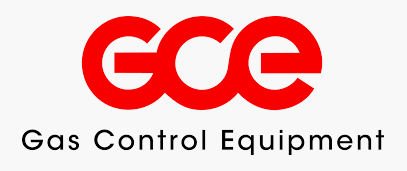
GCE doesn’t just specialize in oxygen concentrator technology, though. They also offer gas supply systems for the analytical and electronic industries along with cutting and welding components like regulators and blowpipes. In 2018, GCE announced a rebranding project where they divided into three separate brands: GCE, GCE Druva, and GCE Healthcare. According to the Executive Vice President, this is a necessary step in their continued evolution and that their company is still committed to safety, innovation, and integrity in everything they do.
About Inogen
Inogen is possibly the most well-established and respected brand in medical oxygen. While they haven’t been around quite as long as companies like GCE, AirSep, or Respironics, they’ve more than demonstrated their worth by producing industry-leading portable oxygen concentrators like the Inogen One G3, Inogen One G4, and Inogen One G5, all of which are still used by thousands of oxygen patients all over the world. Unlike many other oxygen companies out there, Inogen is solely focused on portable oxygen concentrators. While they did manufacture the Inogen at Home oxygen concentrator in the early 2000s, they decided to focus their efforts on portability and mobility.

The Inogen One G5 currently holds the record for the highest oxygen output of any pulse flow portable oxygen concentrator. It also has some of the longest battery life offered by a pulse flow unit. The last generation of oxygen concentrator, the Inogen One G4, is also one of the lightest portable oxygen concentrators ever produced, surpassed only by the AirSep Focus which weighs in at just 1.75 pounds. In general, Inogen continues to move the industry forward, offering patients more reliable and technologically advanced portable oxygen concentrators than ever before.
Maximum Oxygen Output
One of the first issues oxygen patients encounter when choosing an oxygen device is understanding oxygen output. You need an oxygen machine that will meet your needs but you don’t want to have to deal with a heavy and bulky continuous flow portable oxygen concentrator which will severely restrict your freedom and independence. The good news is that pulse flow technology is advancing very rapidly meaning that high-flow oxygen patients no longer have the need to use continuous flow units.
.png)
The Inogen One G5 and the GCE Zen-O Lite are both pulse flow concentrators. What this means is that, instead of outputting a continuous stream of oxygen, they put out “boluses” or “doses” of oxygen whenever the patient inhales. The benefit of this is that the concentrator is not wasting resources by producing oxygen that is never inspired by the patient. The Intelligent Delivery System built into these devices ensures that oxygen is delivered at the optimal moment during the patient’s breath.
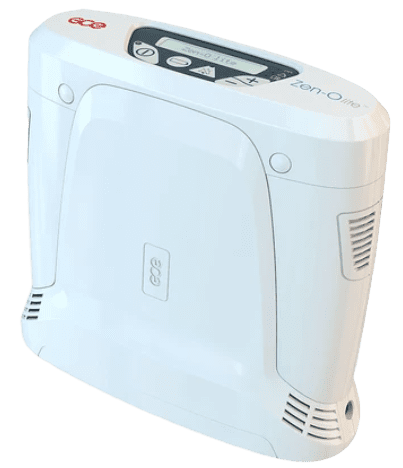
The mistake many people make when comparing continuous flow units versus pulse flow ones is that they assume a 1,000 ml/min output on a pulse flow device is the equivalent of 1 LPM on a continuous flow unit. This is not the case, because pulse flow machines don’t have the wasted oxygen that their continuous flow counterparts do. In turn, the 1,260 ml/min offered by the Inogen One G5 and the 1,050 ml/min offered by the GCE Zen-O Lite should be more than enough to suit the vast majority of oxygen patients. However, it’s best to speak with your pulmonologist before switching over to pulse flow.
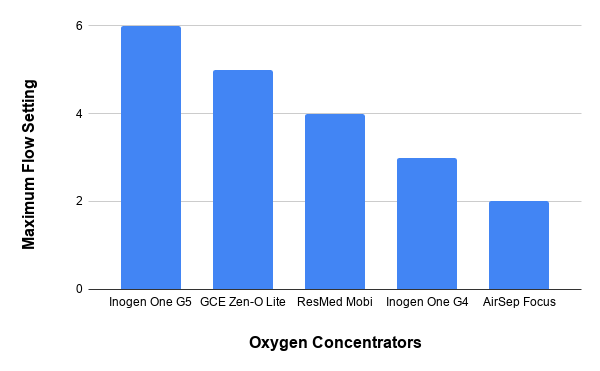
Weight
Weight has always been a serious issue with medical oxygen devices. Home oxygen concentrators that have been in use since the 1970s can weigh upwards of 30 pounds while portable continuous flow units can weigh 20 pounds or more. However, with the advent of portable pulse flow oxygen concentrators, medical oxygen has become much more lightweight and easy to carry by the average oxygen patient.

The Inogen One G5 weighs in at just 4.7 pounds with the 8-cell battery and the GCE Zen-O Lite weighs slightly more at 5.5 pounds. This is around 10 to 15 pounds lighter than your average continuous flow concentrator and 20 to 25 pounds lighter than your average home oxygen concentrator! What’s more, the Inogen One G5 and GCE Zen-O Lite are much more efficient than other pulse flow concentrators with a higher oxygen output per pound.

There’s no understating the importance of having a lightweight portable oxygen concentrator. Oxygen patients tend to get exhausted rather quickly and carrying a heavy oxygen machine can exacerbate symptoms such as chest pain, coughing, and lightheadedness. Additionally, it’s not uncommon for people to suffer from overlapping conditions like back pain or shoulder pain. So, having an oxygen concentrator that’s over 6 pounds is simply not feasible for these people. If you invest in a light and powerful portable oxygen concentrator, you’ll be prepared if your symptoms ever worsen.
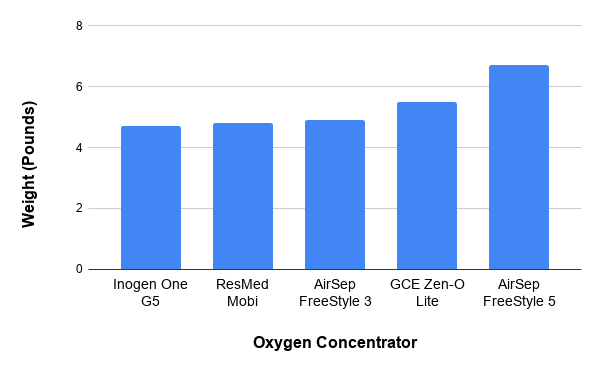
Battery Life
Battery life is another important facet of portable oxygen concentrators. While having a lightweight portable oxygen concentrator will ensure you’re able to lift your device without overexerting yourself, it’s the battery life that will enable you to stay out of the house for as long as possible. The Inogen One G5 has an impressive battery life offering up to 13 hours on one charge while using the 16-cell battery. The GCE Zen-O Lite will offer around 8 hours on one charge with the 12-cell battery.

In the grand scheme of things, both of these portable oxygen concentrators will provide you with ample battery life to get out and enjoy full freedom and independence. Whether you simply want to get out and go to the store or visit friends and family, either of these oxygen concentrators will do. However, if you want to do a lot of traveling, either within the country or outside of the country, the Inogen One G5 will likely be a better option for you.

Another great thing about the impeccable batteries on these two units is that you can significantly extend your runtime by carrying an extra battery or two. By carrying two 16-cell batteries with your Inogen One G5, that will offer you up to 26 hours of battery life and you’ll still be holding under 10 pounds of weight in total. That’s lighter than all continuous flow portable oxygen concentrators on the market! You can even purchase accessories like the Inogen One G5 backpack which will allow you to carry your G5 with ease. It also has plenty of additional space to store extra batteries, your AC and DC power supplies, and other personal belongings.

Sound Level
If you currently use an oxygen tank or portable oxygen cylinder as your primary means of oxygen delivery, you’re likely used to having a quiet device. Since there are no electronic components or moving parts in your oxygen tank, they tend to be very quiet, even when the flow setting has been increased. Fortunately, if you decide to pick up a portable oxygen concentrator like the Inogen One G5 or GCE Zen-O Lite you can expect to be pretty quiet as well.
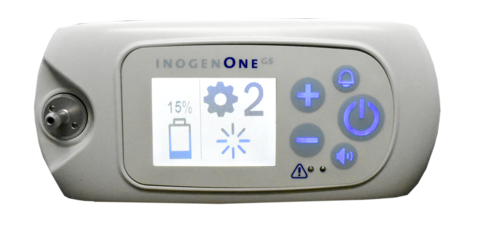
On average, oxygen concentrators emit about 45 decibels (dBA), however, both the G5 and Zen-O are below this at 37 dBA. To put this into perspective, that’s about the sound of a quiet conversation or whisper, even. So, although pulse flow portable oxygen concentrators tend to be louder than oxygen tanks and oxygen cylinders, they’re not loud enough to bother you or people around you.
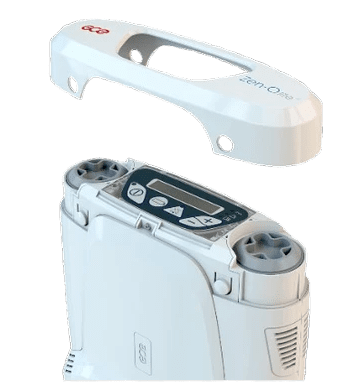
While you’re wearing and using your Inogen One G5 or GCE Zen-O Lite, you’ll feel comfortable going in public places such as a church, library, or restaurant. Although both devices do have audible alarms, they can be turned off by following the directions in your device’s respective user manual. Note, however, that as you turn the POC up to higher flow settings, the sound level will increase as well.
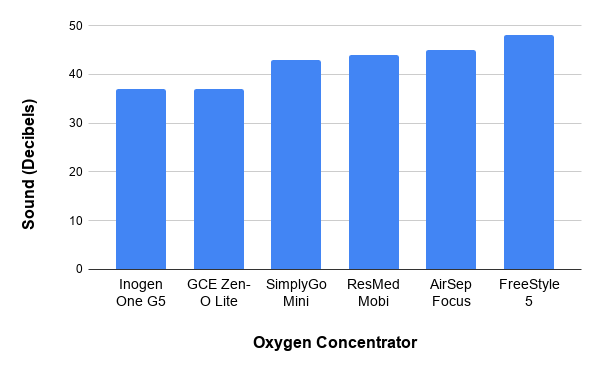
Size
With portable oxygen concentrators becoming lighter and easier to use, we’ve also had the pleasure of seeing them get much smaller. The benefit of having a small portable oxygen concentrator is that it will be easier to carry under your arm or store in tight places. It also makes it easier to carry on public transportation like on a crowded bus or on an airplane. When it’s time for takeoff or landing, you can easily put it under the seat or hold it under your arm.
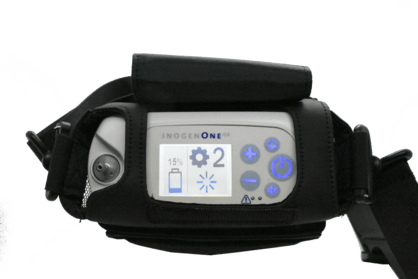
The dimensions of the G5 are 8.15" H x 7.19" L x 3.26" W and the dimensions of the GCE Zen-O Lite are 9.25” H x 9.8” L x 3.8” W. So, they’re fairly comparable in terms of their size, but the Inogen One G5 is a couple of inches smaller all around. This can make a big difference when it comes to taking your portable oxygen concentrator more places and with less hassle. You might also be able to carry several additional accessories that you couldn’t with the Zen-O Lite.
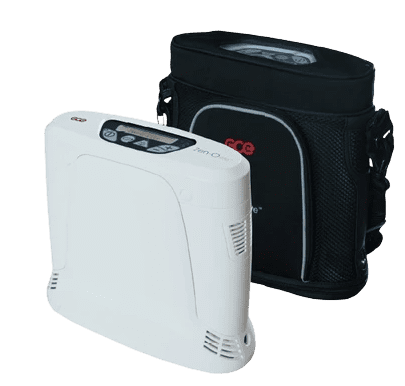
Additional Features
Nowadays, most people expect their electronic devices to come with a lot of features. For example, you’re unlikely to find any phone on the market that can just text and make phone calls. Most modern phones have a wide array of features including the ability to send emails, browse the internet, download apps, and much more. In a way, portable oxygen concentrators are similar. Rather than putting out concentrators that simply do their job, oxygen manufacturers are working to add additional features to their devices which improve ease-of-use, interconnectivity, and freedom.
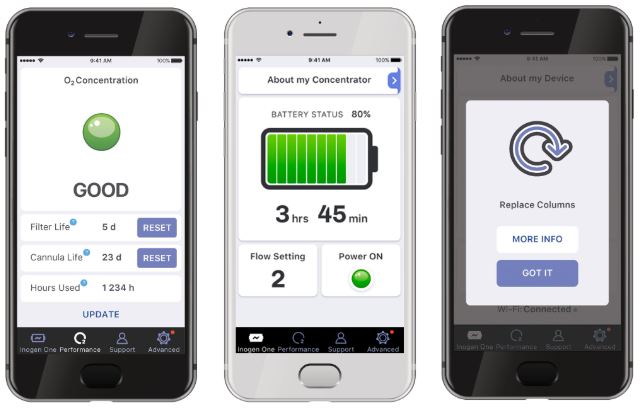
The most notable feature of the Inogen One G5 is the Inogen Connect app. This software was first implemented into the Inogen One G4 back in 2015 and was added to the G5 due to popular demand. The Inogen Connect can be downloaded on any tablet or smartphone device, it can then be connected to your G5 through Bluetooth. When you open the app, it will display important information about your oxygen machine such as battery life, column status, and system integrity. You’ll even have full access to your G5’s user manual so you won’t have to worry about keeping track of the hard copy that came with your device. Although the Inogen Connect is very easy to use and set up, it is by no means mandatory. Your oxygen concentrator will run perfectly fine without it.

Unfortunately, the GCE Zen-O Lite doesn’t come with any features that compare to the Inogen Connect. GCE instead opted to focus on the fundamental aspects of their oxygen machine and avoid any cross-functionality with smartphones and other electronic devices. Whether you see this as a positive or a negative, it may be something to consider when choosing your next portable oxygen concentrator.
Who’s the Ideal Candidate for the GCE Zen-O Lite?
The GCE Zen-O Lite is an all-around great oxygen concentrator. Manufactured by a company that specializes in both industrial and medical oxygen supplies, along with a host of other things, you know that GCE will always offer a reliable and durable product. The Zen-O Lite is their latest portable oxygen concentrator and it’s also one of the most advanced they’ve ever produced.

The Zen-O Lite has a great oxygen output offering over 1,000 ml/min meaning it will work for the large majority of oxygen patients. While it’s not the lightest portable oxygen concentrator, it’s still under 6 pounds so you can easily take it anywhere you go without experiencing back pain or becoming out of breath. It offers enough battery life for you to be able to stay out and about throughout the day without worrying about having the oxygen you need.
{{cta('43b79c5e-6bd6-4f02-ac27-2d038d20c146','justifycenter')}}
Who’s the Ideal Candidate for the Inogen One G5?
Inogen is an oxygen company that tends to never disappoint with their products. In fact, many people eagerly await the release of new Inogen portable oxygen concentrators because they know they will offer groundbreaking new technologies that enable oxygen patients to live a more active and independent lifestyle. The Inogen One G5 is just the latest example of what Inogen is capable of.
.png)
Weighing in at only 4.7 pounds, the Inogen One G5 is one of the lightest on the market. In terms of battery life, the G5 is surpassed only by the CAIRE Freestyle Comfort which provides 16 hours of battery life. The G5 also has the highest oxygen output of any pulse flow portable oxygen concentrator ever produced with 1,260 ml/min of 90% oxygen and 6 flow settings to choose from.
Conclusion
Finding the right portable oxygen concentrator takes time and patience. To start, ensure that the device meets your oxygen needs. If you’re thinking of buying a pulse flow oxygen machine like the Inogen One G5 or GCE Zen-O Lite, you should first speak to your pulmonologist to make sure this oxygen delivery method will work for you. Once you know how much oxygen you need, you can start looking into other aspects of the device such as weight, size, battery life, and ease-of-use.
If you need help choosing the right POC, don’t hesitate to reach out to our oxygen specialists here at LPT Medical. You can reach us by filling out the contact form at the side of the page and we’ll get back to you as soon as possible. In the meantime, keep reading our blog posts to learn more about the best portable oxygen concentrators on the market.

